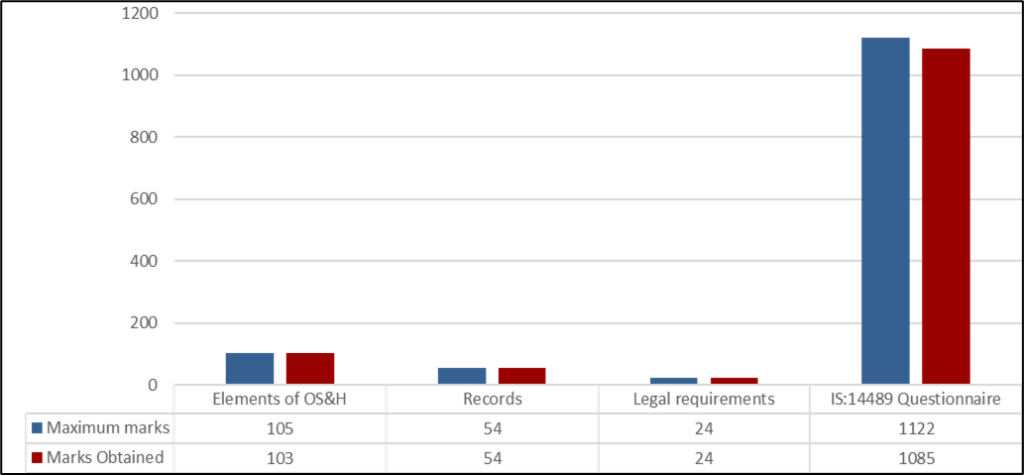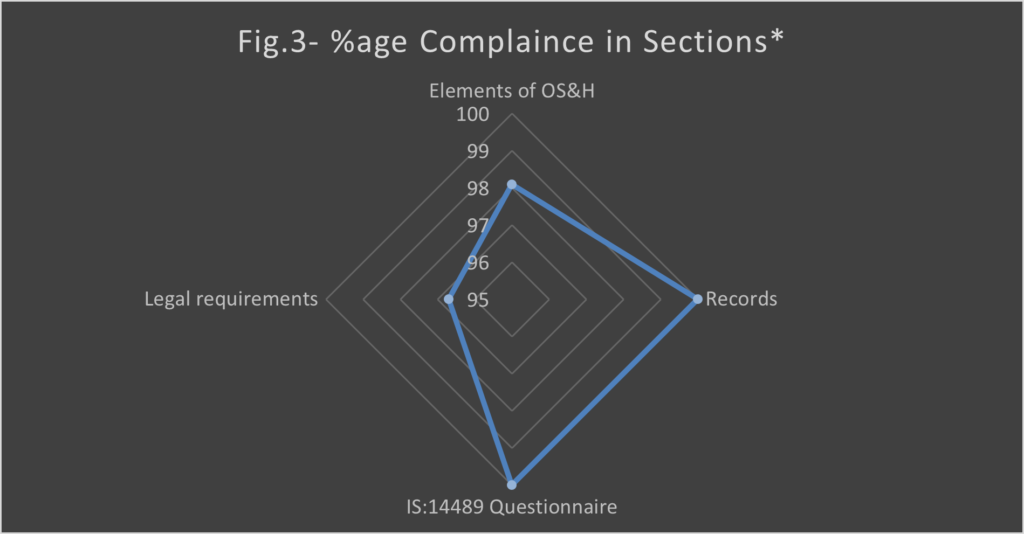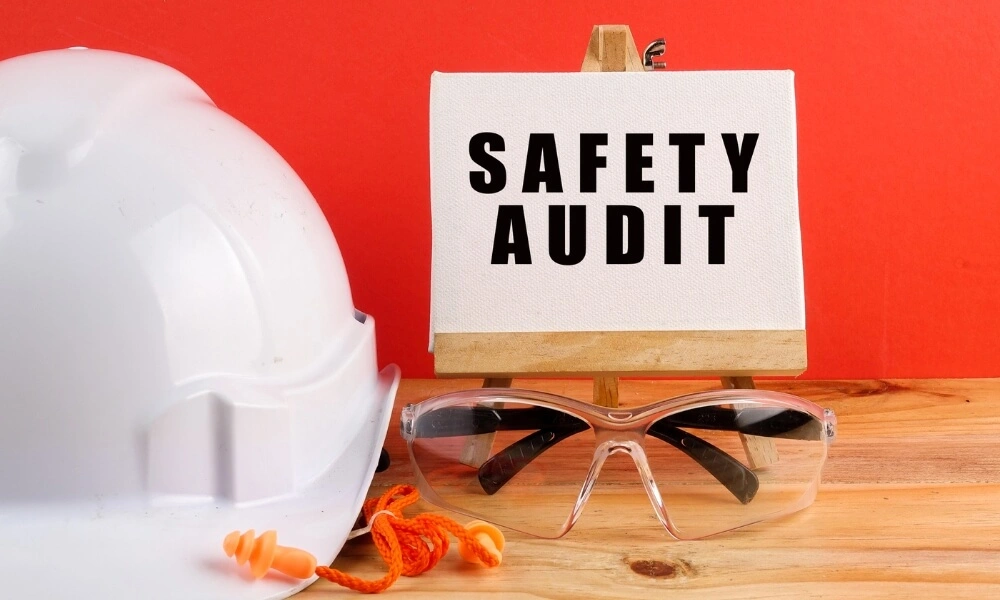Q1 . What is the Objective of Safety Audit?
A1. The objective of Safety Audit is as follows:
The objective of a safety audit is to systematically assess the effectiveness of safety measures and procedures within a workplace or environment. Through the audit process, potential hazards are identified, existing safety protocols are evaluated, and recommendations are made to enhance safety standards and mitigate risks. The ultimate goal is to promote a safe and healthy environment for employees, visitors, and the community.
Q2. What reference is commonly used for Safety Audit?
A2. The reference used for Safety Audit is as follows:
- IS-14489
- The Factory act and rules
- MSIHC Rules
- SMPV Rules
Q3. What is the order of precedence for Safety Audit guidelines/standard?
A3. The order of precedence for guidelines used in Safety Audit is as follows:
- IS-14489
- As per Client Guidelines
- Other international standards

Q4. What is the methodology used for Safety Audit?
A4. The methodology for Safety Audit is as follows:
- Opening Meeting – Before starting safety, audit safety auditor will hold an opening meeting with auditee team members from client. The agenda for opening meeting will be of sharing pre-audit finding and discussion on major area of focus as regard to dangerous machines/operation/applicable schedules/chemical hazards/applicable act & rules
- Site observations – Site observation will be noted by the auditor in separate sheets as per chapter 3 of this manual in separate sheets and area wise. The observation will include unsafe conditions and practices observed during the plant visit
- Document Verifications – The documents are verified on site as well as in the conference room. Some of the critical documents must be kept in fire safe that also has to be verified and tagged.
- Debriefing Meeting/Closing Meeting – The closing meeting provides high-level authorities with information relating to the findings and recommendations of the audit team. The meeting should ensure that the auditee team members/industry clearly understand the situation as audited by the HSE Consultant team and are able to start work on a corrective action plan, should it be deemed necessary. The meeting should emphasize the most significant safety issues and concisely present the team’s findings and opinions regarding the effectiveness of the Industry’s safety system.
- Reporting and Recommendations – At the end of the Audit, a comprehensive safety audit report will be provided on the findings of the Audit and recommendations for the next course of action. The recommendations suggested for risk improvement are given.

Q5. What are the documents required for conducting Safety Audit?
A5. The documents required for the Safety Audit include the following:
- Scope of work
- Hazardous inventories and their SDS
- Process description
- Equipments & Details
Q6. What are documents deliverables for Safety Audit?
A6. The documents deliverables for Safety Audit are as follows:
- Executive Summary
- Safety Audit Methodology
- Participant Attendance sheet
- Compliance Summary Report
- System’s Ability
- Reference
- List of tables
- List of Appendix:-
- Element of OS&H System
- Records examined during the Safety Audit
- Safety Audit Questionnaire
- Legal Requirement
- Site Observation
- Good Practice
- Last Audit Status Review
- Comments Resolution sheets
Q7. Which software will be used for the Safety Audit?
A7. Following software will be used for Safety Audit
PHA Pro version 8.19 software.

Q8. What is the Statutory Requirements of Safety Audit?
A8. Statutory Requirements for Safety Audit are as follows:
- As per Manufacture, Storage and Import of Hazardous Chemical Rules, 1989 (consolidated version with subsequent amendments), Rule 10(4) “The occupier of both the new and the existing industrial activities shall carry out an independent safety audit of the respective industrial activities with the help of an expert, not associated with such industrial activities.”
- As per Manufacture, Storage and Import of Hazardous Chemical Rules, 1989 (consolidated version with subsequent amendments), Rule 10(6) “The occupier shall update the safety audit report once a year by conducting a fresh safety audit and forward a copy of it with his comments thereon within 30 days to the concerned Authority.”

Q9. What is the definition of Shall and Should in Safety Audit?
A9. The definition of Shall and Should in Audit term is as follows:
- Shall: Indicates a mandatory requirement. This is generally used for legal requirement.
- Should: Indicates a recommendation or that which is advised but not necessary to do compulsory.
Q10.How Scores are given in Safety Audit?
A10. Scores are given in Safety Audit based on following points:
Health and Safety Audit give us opportunity to evaluate our system quantitatively both unit wise and department wise. It can be used as a performance measuring tool. Scoring is done on the basis on Low Risk, Medium Risk and High Risk of Observation and Recommendations.

Q11. What information does the Compliance Summary Report of a Safety Audit Report typically include?
A11. The summary of Safety Audit Report includes the following:
- The Audit Score Card is a tool to assess the environmental, health and safety (EHS) compliance of a facility. The Score Card is composed of 7 thematic sheets (corresponding to the 7 modules of the Audit Protocol), which contains all of the documentation needed to complete the audit and a heading guidance tab, which explains the types of issues that are covered under each thematic heading.
- Each subject sheet provides a number of compliance questions covering the main EHS regulatory requirements. The questions are grouped into thematic sections. Each question has a unique number and comes with a regulatory citation.
| Section | Maximum Marks | Obtained Marks | %age compliance | Weightage | Total Marks Obtained |
| Elements of OS&H | |||||
| Records | |||||
| IS:14489 Questionnaire | |||||
| Legal requirements | |||||
| Site Observations | |||||
| Last audit Status review | |||||
| Overall Compliance |
Q12. How marks are given for Site Round observations?
A12. Marks for Site Round is given on the basis of following table:
| Site Round Marks (Negative) | Marks to be deducted |
| 0-25 | 0% |
| 25-50 | 25% |
| 50-75 | 50% |
| 75-100 | 75% |
| Above 100 | 100% |
Q13. How are recommendations typically categorized?
A13. Recommendations in a Safety Audit are typically categorized into the following:
Recommendations in a Safety Audit are typically categorized into the following:
- Administrative
- Hardware
- Software
Q14. What information does the executive summary of a Safety Audit Report typically include?
A14. The information in Executive Summary include following points:
The executive summary of a Safety Audit Report typically includes a condensed overview of key findings, recommendations, and conclusions derived from the audit process. It typically includes:
- Introduction and Scope: A brief overview of the audit objectives and the scope of the audit, including the areas and processes assessed.
- Summary of Findings: Highlights of significant findings from the audit, focusing on key observations related to safety performance, compliance with regulations, and adherence to safety policies and procedures.
- Risk Assessment: Summary of identified risks and hazards, including any high-risk areas or critical safety concerns that require immediate attention.
- Compliance Status: Overview of the organization’s compliance with relevant safety regulations, standards, and internal policies, highlighting any areas of non-compliance or deficiencies.
- Strengths and Weaknesses: Summary of notable strengths in the organization’s safety management system, as well as identified weaknesses or areas for improvement.
- Recommendations: Summary of recommended actions to address identified deficiencies, mitigate risks, and enhance safety performance.
- Conclusion: Overall assessment of the organization’s safety performance based on the audit findings, emphasizing key takeaways and next steps for improvement.
- Management Response: In some cases, the executive summary may include a section for management responses to the audit findings and recommendations, outlining proposed actions and timelines for implementation.
Q15. What is the criteria for comparing compliance achieved in Safety Audit?
A15. Compliance achieved in Safety Audit is based on following points:
| >85% | Excellent |
| 75%-85% | Very Good |
| 65%-75% | Good |
| 50%-65% | Average- Involvement of Middle Management required |
| <50% | Below Average- Involvement of Top Management required |

Q16. What is the criteria for Analysis and Roadmap for Further Actions?
A16. Analysis and Roadmap for Further Actions are based on following points:
| 75-100 % | Action Monitoring System and Auditing System to be Strengthen |
| 50-75% | Shopfloor Management should make Action Plan for Improvement |
| <50% | Involvement of top Management includes directors to make high level policies for complying category D recommendations. This requires Human resources, financial resources, financial support, motivational and encouraging policies |
Q17. What is the Format of Site Observation in Safety Audit Report?
A17. Site Observation in Safety Audit is provided in following format:

Q18. What is the Format of Site Observation in Safety Audit Report?
A18. Good Practices in Safety Audit is provided in following format:

Q19. What is the Format of Recommendation in Safety Audit Report?
A19. Recommendations in Safety Audit is provided in following format:

Q20. What are the graphical methods used to interpret safety audits?
A20. Graphical Methods used to interpret safety Audit outcomes are as follows:




Q21. What are the Elements of Safety Audit?
A21. The Elements of Safety Audit are as follows

Q22. What is Comment Resolution Sheet?
A22. The meaning of Comment Resolution Sheet (CRS) is as follows:
A comment resolution sheet is a document used to track and address comments, feedback, or issues raised during a review process, audit, or evaluation.

DISCLAIMER
This Blog is provided solely for informational and educational purposes. It is advisable to verify all information presented and consult with appropriate experts or professionals before making any decisions or implementing any strategies based on the content of this blog. HSE Risk Management Services Pvt. Ltd. accept no liability for any actions taken or not taken based on the information provided herein.

Leave a Reply